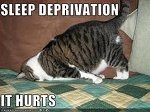-SWS wrote:
Robysue, are you certain your "tickling" wasn't FOT commencing at the 4-second mark for longer-than-usual expiratory pauses? What can we estimate the proportional magnitude of the 3cm's rise to be right where I drew that green line? I'm kinda eyeballing it at around half a cm, while FOT is 1cm peak-to-peak.
Unless it was tickling on EVERY single exhale? I don't take that long to exhale on EVERY single breath. And when the tickles happen, they happen on EVERY single breath.
Now I'll admit, when fully conscious I could easily detect those FOTs on really LONG exhales of the sort associated with a really deep, deep sigh or consciously relaxing deep breath that I found almost impossible to do with CPAP/APAP because it triggered getting a stomach full of air on the exhale. [It's still NOT easy with the biPAP because the inhale for such a breath is deeper than normal and that also runs the risk of my getting air in my tummy.] Same thing with the PR: If I am fully conscious and don't inhale for long enough, I can sure detect the silly puffs the PR sends my way to try to determine if the "apnea" is an OA or a CA.
Now I don't know if my normal breathing pattern is all that funny or not. But I don't think I've got a funny breathing pattern (I don't have any diagnosis of any breathing disorder OTHER than OAS), so it may simply be that I am more aware of the "flat" portion of the wave form of my breath pattern and think of it as belonging to the exhale rather than the inhale. I also know that sometimes I'll exhale for a bit, stop for the merest fraction of a second, and then start
exhaling again if my nose is itchy or feels stuffy. And during that moment between the two parts of the exhale, the S9 always seemed to start increasing the pressure. Maybe I should dig up some old wave form data from the S9 and post it and y'all can tell me if it looks funny to you.
To further muddy the waters, here's the graphic of Bi-Flex off the Resprionics website. Now, I can't find a picture of the Rise Time wave form, but as I recall, it was much more a regular square wave: There was no dip below the EPAP at all---just a vertical line dropping the pressure immediately down to EPAP at the start of the exhale, and instead of a vertical rise at the start of the inhale, there was a small lag in time up to full IPAP pressure, but the shape was still more or less a vertical line. (The drop back down to EPAP was a vertical line, unlike the form shown for the highest Bi-Flex settings.)

Now compare the Bi-Flex picture and what I described for the Bi-Flex = OFF (NO dip below the EPAP line at ALL---i.e. A FLAT pressure line during the ENTIRE exhale phase of the breath) to the EPR Easy breath pictures previously posted:


In the first, there's hardly ANY flat transition in the patient's airflow---i.e. a spot where the patient is not actively breathing in nor out at a significant rate: That is NOT true of my breath pattern---I do typically have a well defined pause after most exhales where there is little or no air moving before starting the next inhale, and psychologically I think of this as being part of the "exhale" regardless of how the machine attached to my nose decides to interpret the flow data. And in the later, it's quite clear (due to -SWS's clever added drawings) that the pressure DOES start a very subtle increase during the flat part of the breath when there's very little air moving in or out of the patient's nose---the part of the breath that I identify as being part of my exhale and that small, but subtle increase in pressure does make me feel like the S9 is trying to rush me to breathe in.
NOTE 1: I felt just as rushed (probably MORE rushed actually) when I did a 30 minute experiment with Bi-Flex the first night I had the PR S1 BiPAP. Given these graphs is it any wonder that I so quickly discovered that I needed to turn Bi-Flex OFF?
NOTE 2: If
bi-level means TWO distinct pressure levels that are maintained during each and every breath, then I'm not sure EPR's Easy Breath wave form really is
bi-livel. I'm not saying that it is not comfortable. I'm sure it's quite comfortable for many, if not most people. But a
constant pressure is maintained in neither the majority of time during the inhale or exhale portion of the breath. The pressure is repeatedly peaking at what is approximating an IPAP pressure and it's momentarily bottoming out during part of the exhale at what is approximating an EPAP. But that's not the same as having a constant EPAP throughout the entire exhalation part of the breath.
NOTE 3: Note that in the bi-level the pressure drops immediately to EPAP when the exhale starts. With EPR, the pressure starts to drop (even before the exhale starts), but does NOT reach the minimum exhale relief pressure until well after most of the exhalation effort has been done (as measured by the lowest part of the patient's flow wave). That is another critical difference between real bi-level and the EPR algorithm. And in my opinion, in this sense, EPR ain't the real thing.





















